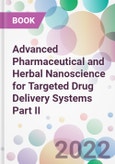This 2-part reference informs readers about the application of drug delivery technologies to herbal medicines. Chapters cover a broad range of major topics on the subject of targeted drug delivery systems. These topics include the application of drug delivery systems for herbal nanomedicines, drug development issues, emerging technologies, adaptations for clinical use, market prospects and challenges of industrial commercialization. Chapters have been contributed by several experts in pharmaceutical chemistry and blend theoretical knowledge with practical aspects of drug delivery.
Part II covers the following topics:
Part II covers the following topics:
- Pharmaceutical nanosciences and their application in the delivery of various phytoconstituents
- Design of cosmeceutical drug delivery systems: the role of nanotechnology in cosmeceuticals
- Transfersomes: a novel vesicular transdermal delivery system
- Self-nano/micro emulsified drug delivery systems
- Phytosomes
- The role of nanomedicines in ocular drug delivery systems
- Colloidosomes as an efficient novel drug delivery system: an update
- Herbal nanoscience: challenges and regulatory perspectives
- Vitamins based nanomedicine approach
- Dendrimers: a versatile nanoplatform for advanced targeting and bioactive(s) delivery
- Targeted drug delivery systems for cells and cell organelles
- Liposomes for herbal drug delivery
- AI in pharmacy, herbal medicine and drug delivery: sci-fi or reality?
Table of Contents
Chapter 1 Pharmaceutical Nanosciences and Their Application in the Delivery of Various Phytoconstituents- Retno Widyowati and Andang Miatmoko Introduction
- Phytoconstituents in Herbal Medicine
- Phenolic
- Terpenoid
- Alkaloid
- Anthraquinone
- Nanotech for the Delivery of Different Phytoconstituents
- Liposome
- Microemulsion
- Solid Lipid Nanoparticles and Nanostructured Lipid Carriers
- Inorganic Nanoparticles
- Liquid Crystalline Systems
- Polymer Nanoparticles
- Dendrimers
- Therapeutical Application
- Cancer
- Rheumatoid
- Nutraceutical Delivery
- Conclusion
- Consent for Publication
- Conflict of Interest
- Acknowledgements
- References
- Merits of Nanocosmeceuticals
- Demerits of Nano Cosmeceuticals
- Novel Nanocarriers in Cosmeceuticals
- Niosomes
- Liposomes
- Nanocapsule
- Lipid Nanoparticles and Lipid Nano-Carriers (Sln and Nlc)
- Nanogold and Nanosilver
- Nanoemulsions
- Nano Sphere
- Cubosomes
- Major Nanocosmeceutical Class
- Skincare
- Haircare
- Lip Care
- Nail Care
- Nanotechnology in Herbal Drugs- Nanophytomedicine
- Nanocurcumin
- Green Nanotechnology (Cumin- Mediated Gold Nanoparticle)
- Ayurvedic Bhasma
- Aloe Vera Extract in Nanoparticles
- Emerging Challenges and Potential Solutions
- Cellular Toxicity of Zinc Oxide and Titanium Dioxide Nanoparticles
- Occupational Risks of Nanoparticles
- Potential Solutions
- Physical-Chemical Properties
- Mathematical Modelling
- Microscopic Techniques
- In Vitro Methods
- Future Prospect of Nanotechnology in Nano Cosmeceuticals
- Conclusion
- Consent for Publication
- Conflict of Interest
- Acknowledgements
- References
- Nagaraja Sreeharsha and Santosh Fattepur Introduction
- Advantages and Disadvantages
- Composition and Its Mechanism
- Transfersomes Penetration Mechanism
- Application of Transfersomes as the Transdermal Delivery System
- Delivery of Antioxidant
- Delivery of Anticancer Drug
- Delivery of Corticosteroids
- Delivery of Anti-Inflammatory Drugs
- Delivery of Insulin
- Delivery of Protein and Peptide
- Delivery of Interferon
- Delivery of Anesthetics
- Delivery of NSAIDs
- Delivery of Herbal Drug
- Regulatory Aspects
- Limitation of Transfersomes
- Future Perspective
- Conclusion
- Consent for Publication
- Conflict of Interest
- Acknowledgements
- References
- Vishal Trivedi and Jiyauddin Khan Introduction
- Herbal Medicine is a Novel Drug Delivery System
- Herbal Nanomedicines of Snedds and Smedds
- Self Emulsification Process
- Self-Nano Emulsifying Drug Delivery System (Snedds)
- Self-Micro Emulsifying Drug Delivery System (Smedds)
- Ingredients Required for the Formation of Self-Emulsification Drug Delivery System
- Excipients
- Surfactants
- Co-Surfactant
- Important of Sedds
- Mechanism of Sedds
- Dosage Forms from Sedds
- Dry Emulsions
- Sustained and Controlled-Release Tablets
- Self-Emulsifying Suppositories
- Implants of Self-Emulsifying
- Drug Properties and Characterization of Sedds
- For the Characterisation of Sedds
- Bioavailability Enhancement of Drugs by Sedds
- Snedds and Smedds Improved Dissolution Rate and Bioavailability of Poorly Soluble Drug
- P-Glycoprotein Inhibition
- Snedds and Smedds Drug Delivery System for Improving the Bioavailability/Lymphatic Uptake/Liver Uptake/ Peptide
- Advantages of Self-Emulsifying Drug Delivery
- Disadvantages of Self-Emulsifying Drug Delivery Systems
- Emerging Challenges and Potential Solutions of Snedds and Smedds
- Marketed Products of Sedds
- Future Prospects
- Conclusion
- Consent for Publication
- Conflict of Interest
- Acknowledgements
- References
- Phytosome/Herbosome/Pharmacosome/Liposome
- Phytosome or Herbosome
- Pharmacosomes
- Liposomes
- Phytosome Vs. Liposome
- Prerequisites for Phytosome/Herbosome/Liposome Formation
- Selection of Active Phytoconstituents or Standardized Extract
- Phospholipids
- Structure of Phospholipids
- Glycerophospholipids
- Sphingomyelins
- Phyto-Phospholipid Complex: Phytosome Technology
- Properties of Herbosomes (Phytophospholipid Complex)
- Physical Properties
- Chemical Properties
- Biological Properties
- Merits of Phytophospholipid Complexes (Herbosomes)
- Preparation of Herbosomes
- Phospholipids
- Solvents
- Phytoconstituents
- Methods of Preparation of Herbosomes
- Anti-Solvent Precipitation
- Solvent Evaporation Method
- Ether Injection Method
- Rotary Evaporation Method
- Novel Methods for Herbosomes Preparation
- Dosage Forms of Herbosomes
- Capsules
- Hard Gelatin Capsule
- Soft Gelatin Capsule
- Tablets
- Topical Preparations
- Optimization of Herbosomes
- Characterization of Herbosomes
- Partition Coefficient and Solubility
- Particle Size and Zeta Potential
- Yield
- Entrapment Efficiency
- Crystallinity and Polymorphism
- Stability of Vesicles
- Transition Temperature
- Measurement of Surface Tension Activity
- Drug Release
- Spectroscopic Confirmation of Herbosomes
- Fourier Transform Ir Spectroscopy
- Proton Nmr (1H Nmr)
- 13C Nmr
- Sem/Tem
- X-Ray Diffraction
- Marketed Herbosomes
- Limitations of Herbosomes
- Future Perspectives of Herbosomes
- Conclusion
- Consent of Publication
- Conflict of Interest
- Acknowledgements
- References
Author
- Swarnlata Saraf
- Ram Kumar Sahu
- Vivek Dave









